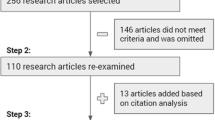Abstract
This paper identifies how ontology models can be vigorously used to define semantics and relationships in representing objects/modules for e-learning, business modeling support and manufacturing processing details. Further extraction of these relations by intelligent decision-support systems using data mining as a tool is discussed. The paper envisages the possibility of establishing a common solution platform for product development and customization leading to increased profitability and better resource utilization. It showcases ways to link these different ontological models leading to cross platform compatibility. It also tries to explore manufacturer-customer relationship and using them to provide quality analysis methods for further improvement in the product processing model.
Similar content being viewed by others
References
Agard, B., & Kusiak, A. (2005). Data mining for selection of manufacturing processes, chap. 54. Data Mining and knowledge discovery handbook, Springer, US.
Buchner A., Anand A., Huges J., Smyth P. (1997) Data mining in manufacturing environments: Goals, techniques and applications. Studies in Informatics and Control 6(4): 319–328
Chang, H., & Chung, L. (2003). A data mining approach to dynamic multiple responses in Taguchi experimental design. Quality and Reliability Engineering International, 19.
Chen, R., Yeh, K., Chang, C., & Chien, H. (2006). Using data mining technology to improve manufacturing quality-a case study. In Seventh ACIS international conference on software engg., AI, Computing.
Cochrane S., Young R., Case K., Harding J., Gao J., Dani S., Baxter D. (2008) Knowledge reuse in manufacturability analysis. Journal of Robotics and Computer Integrated Manufacturing 24: 508–513
Codd E. (1990) A relational model for large shared data banks. Communications of the ACM 13(6): 377–387
Duan, R., Prodan, R., & Fahringer, T. (2006). Data Mining based Fault prediction and detection on the grid. In 15th IEEE international symposium on high performance distributed computing (pp. 305–308).
Elmarie, E. (2003). A look at e-learning models: Investigating their value for developing an e-learning strategy. Bureau for Learning Development, Unis.
Fayyad U., Piatetsky S., Smyth G. (1996) Advances in knowledge discovery and data mining. AAAI Press/The MIT Press, Cambridge, MA
Gordijn J., Akkerman J. (2001) Designing and evaluating e-business models. IEEE Intelligent systems 16(4): 11–17
Gunasekaran A., McNeil R., Shaul D. (2002) E-learning: Research and applications. Journal of Industrial and Commercial Training 34(2): 44–53
Hamel G. (2000) Leading the revolution. Harvard Business School Press, Boston
Jarrar M. (2008). Towards effectiveness and transparency in e business transactions-an ontology for customer complaint management, chap. 20. Semantic web methodologies for e-business applications.
Kitamura Y., Mizoguchi R. (2004) Ontology based systemization of functional knowledge. Journal of Engineering Design 15(4): 327–351
Kusiak A. (2000) Decomposition in data mining: An industrial case study. IEEE Transactions on Electronics Packaging Manufacturing 23(4): 345–353
Li, Z., Raskin, V., & Ramani, K. (2008). Developing engineering ontology for information retrieval. Journal of Computing and Information science in Engineering, 8.
Masullo, M., Messier, P., & Criscenti, D. (2005). Agile learning in agile manufacturing: An e learning model. In 5th Conference of the society of applied learning.
McCarty J., Hastak M. (2007) Segmentation approaches in data mining: A comparison of RFM, CHAID and logistic regression. Journal of Business Research 60: 656–662
Nanda, J., Simpson, T.,& Shooter, S. (2006). A methodology for product family ontology development using formal concept analysis using web ontology language. Journal of Computing and Information science, ASME, 6.
Osterwalder, A., & Yves Pigneur, J. (2002). An e-business model ontology for modeling e-business. In 15th Bled electronic commerce conference.
Pigneur, Y., & Osterwalder, O. (2002). An e-business ontology for modeling e-business. In 15th Bled electronic commerce conference e-reality.
Radhakrishnan R. (2006) Information retrieval at boeing: Plans and processes. ACM SIGIR, Seattle, WA
Rosenberg M. (2001) Strategies for delivering knowledge in the digital age, 1. McGraw Hill, NY
Royers, G., & Joyner, E. Mining your data for healthcare quality improvement. SAS Institute Inc.
Saremi, A., Esmaeili, M., & Habibi, J. (2006). O2DSS: A framework for ontology driven support systems in pervasive computing environment. In IEEE-second asia international conference on modeling and simulation.
Simpson, T., Kumara, S., & Moon, S. (2008). Dynamic multiagent system based on a negotiation mechanism for product family design. IEEE Transactions on Automation Science and Engineering, 5(2).
Simpson, T., Thevenot, H., & Alizon, F. (2007). An index based method to manage the tradeoff between diversity and commonality during product family design. Journal of Concurrent Engineering Research and Applications, 15(2).
Soininen T., Tiihonen J., Mannisota T. (1998) Towards a general ontology of configuration. Artificial Intelligence Engineering Design 12(4): 357–372
Srinivas, S., Kusiak, A., & Harding, J. A. (2005). Data mining in manufacturing: A review. Journal of Manufacturing Science and Engineering, ASME, 128.
Xindong W., Kumar V., Quinlan J., Ghosh J., Yang Q. et al (2007) Top 10 algorithms in data mining. Knowledge and Information system (Springer) 14: 1–37
Zhong, N., & Li, Y. (2006). Mining ontology for automatically acquiring web user information needs. IEEE Transactions on Knowledge and Data Engineering, 18(4).
Zhou, J., & Dieng-Kuntz, R. (2004). Manufacturing ontology analysis and design: Towards excellent manufacturing. In IEEE international conference on industrial informatics INDIN.
Zimmermann, M. (2005). eLearning in manufacturing processes: Implementation by integrated web services and streaming services. In IEEE advanced industrial conference on telecommunications.
Author information
Authors and Affiliations
Corresponding author
Rights and permissions
About this article
Cite this article
Bhattacharya, A., Tiwari, M.K. & Harding, J.A. A framework for ontology based decision support system for e-learning modules, business modeling and manufacturing systems. J Intell Manuf 23, 1763–1781 (2012). https://doi.org/10.1007/s10845-010-0480-6
Received:
Accepted:
Published:
Issue Date:
DOI: https://doi.org/10.1007/s10845-010-0480-6




